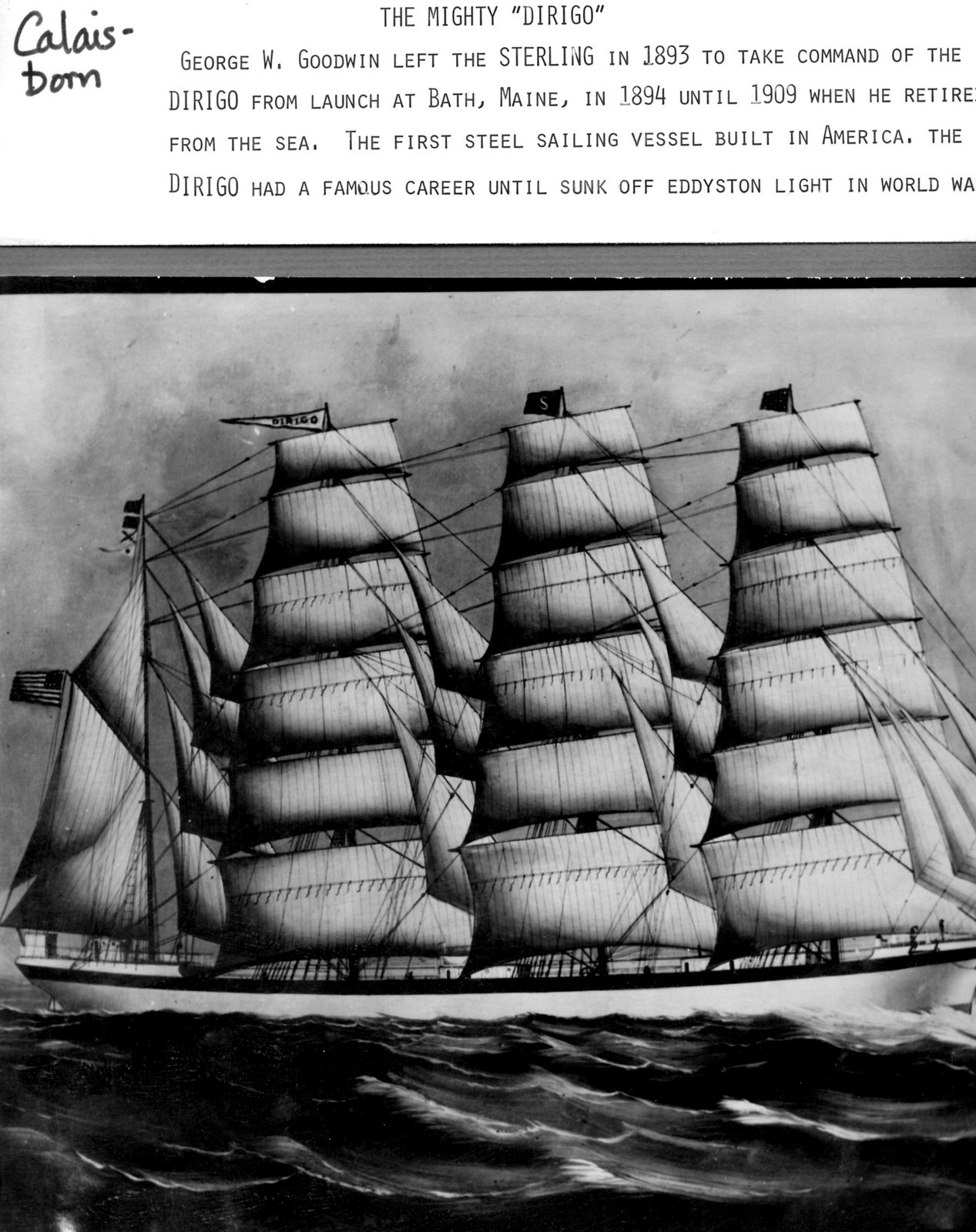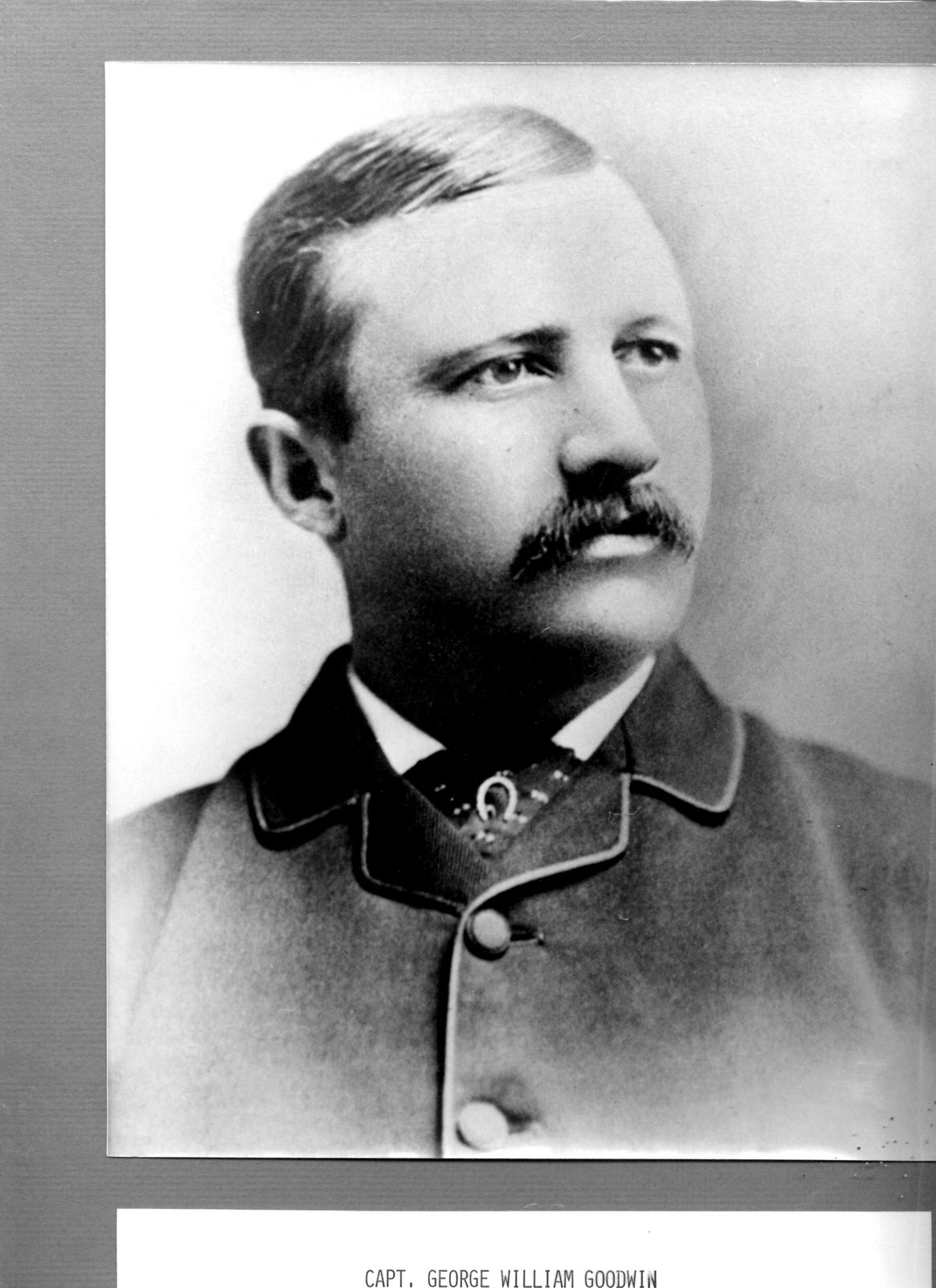
Of Downeast ships and sea captains there has been much written over the years. Captains of seagoing vessels were thick on the ground Downeast in the mid to late 1800’s. Red Beach alone was said to have had a dozen captains sailing the wide world at any given time-Cooks, Youngs, Nobles, Warnocks, the list is endless. Of one, however, and perhaps the most famous local sailor to captain a ship on the world’s oceans, little has been written. He is George W. Goodwin, pictured above.
George Goodwin was born in Calais in 1848 to John Goodwin and Mary Dyer and was a direct descendant of some of Calais’ first settlers. He grew up in a city dominated by the St. Croix River through which lumber, the wealth of the St. Croix Valley flowed in exchange for both basic necessities and exotic goods from the east. It is not surprising he took to the sea as a very young man.
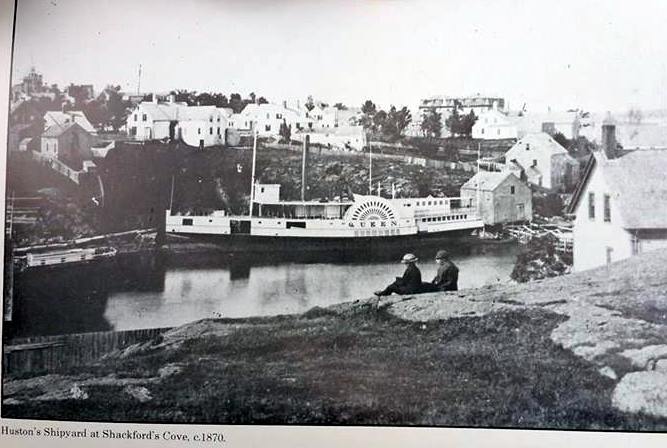
Sidewheeler river steamer Queen in Eastport, probably about late 1860s
He started as cabin boy at age 13 in the steamer Queen running between Calais and Eastport and at 16 went coasting between Calais and Boston.
In 1864 the boy took his first trip “off shore” as going to the West Indies was called by Mainers in those days. The vessel was the bark Villa Franca bound to Barbados. Of the voyage he told the Brunswick Maine Daily Record in 1913:
“I shall never forget my first experience in furling the main royal. It was when we were crossing the Gulf Stream on a dark squally night when I got aloft to the royal yard it seemed as if I was up amongst the clouds.
“I couldn’t see the deck or much of anything else. All at once everything was lighted up with what looked like an electric light on each yard arm and one right over my head on the royal pole, I’d heard enough to know what they were but I was frightened just the same. Reading about corposants (St. Elmo’s Fire) and being within a few feet of them in a gale of wind are two different things. It blew hard during the night and the old tub labored so that we had to jettison part of the deckload.
“At Barbadoes we received orders to proceed to Port of Spain to discharge. I think discharging that cargo of wet slimy lumber was the hardest work I ever did. There were five boys and three-men in our crew. The boys had to do men’s work and got only half as much pay.
“Off Hatteras on the run home we sprung a leak and I think about half the North Atlantic must have filtered in through the bark’s bottom. We worked night and day at the pumps without any let-up. While shortening sail I fell from the main top gallant yard, bounced from one thing to another, lit in the main rigging, broke several ratlines and then came down on deck. I fell about 70 feet but with the exception of a few black and blue spots and a little of the skin brushed off I was in shape to be back at work again in a few days”. The boy soon afterward enlisted in the army “for one year or during the war” he says he got all the soldiering he wanted but no fighting.
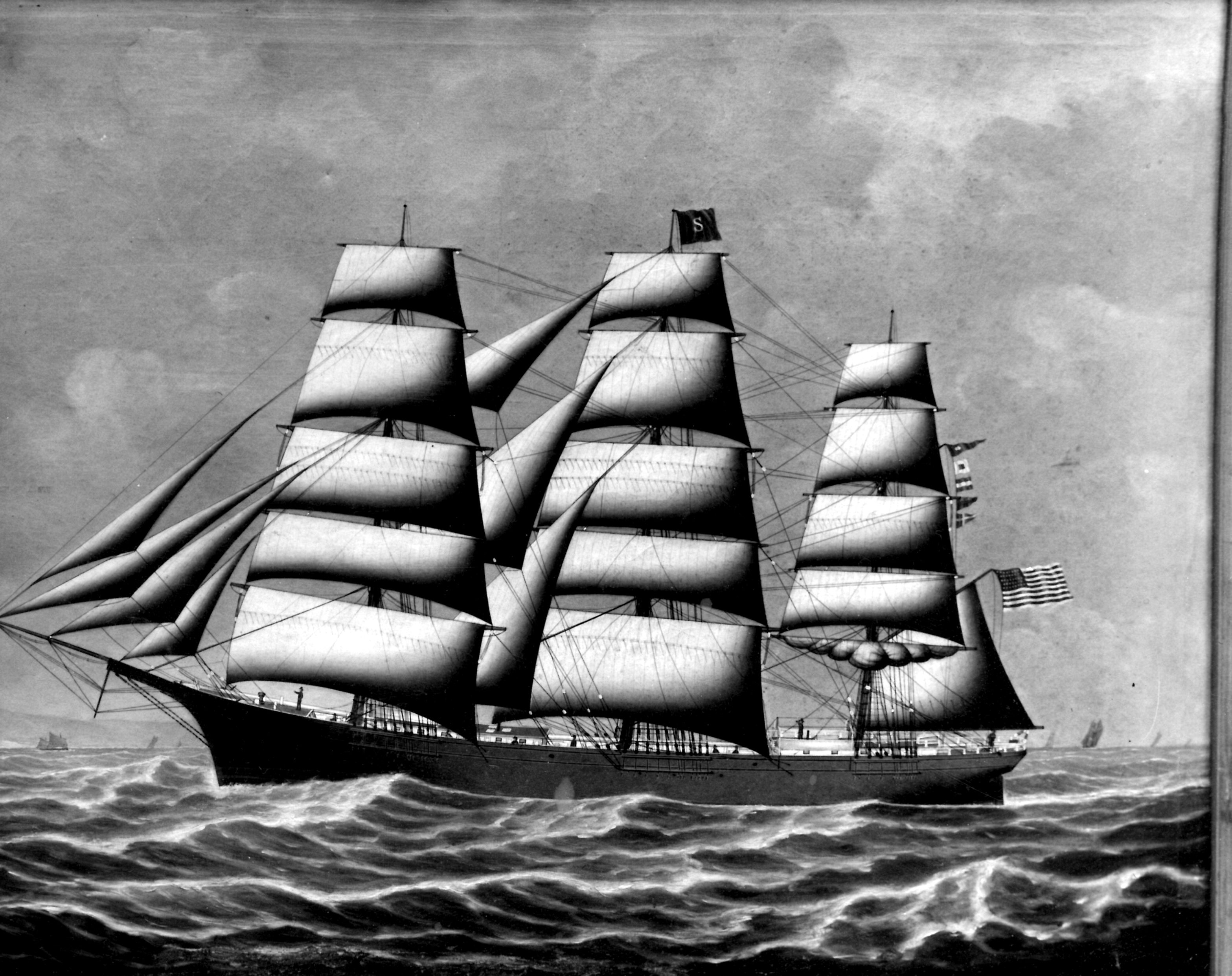
Schooner Sterling, Goodwin’s first command
These experiences did not discourage Goodwin from following the sea and he continued to impress those who counted with his ability to handle both ships and men. By the 1870’s he was sailing as first mate on the Louisiana and in 1873 while in San Francisco became the first mate of the newly built 1830-ton Sterling on which he served as mate until 1881 when he was given command of the ship. The Sterling made several trips around the world, returning with tea and spices from China and transporting wine, salmon and other fine foods to England and European ports. On its first journey after Goodwin became captain the ship transported another precious commodity- Goodwin’s new wife, Ada Grafton of Calais. Ada was the daughter of John Grafton, the owner of the livery stable adjacent the St. Croix Hotel.
They spent their honeymoon on a perilous trip around Cape Horn where Ada proved as able as any seaman. She became an excellent sailor and navigator, raised her child aboard ship, and saved the ship from disaster on several occasions by her alertness. She may also have entertained the crew with her talent as a singer. Ada was the featured singer at her 1875 Calais Academy graduation.
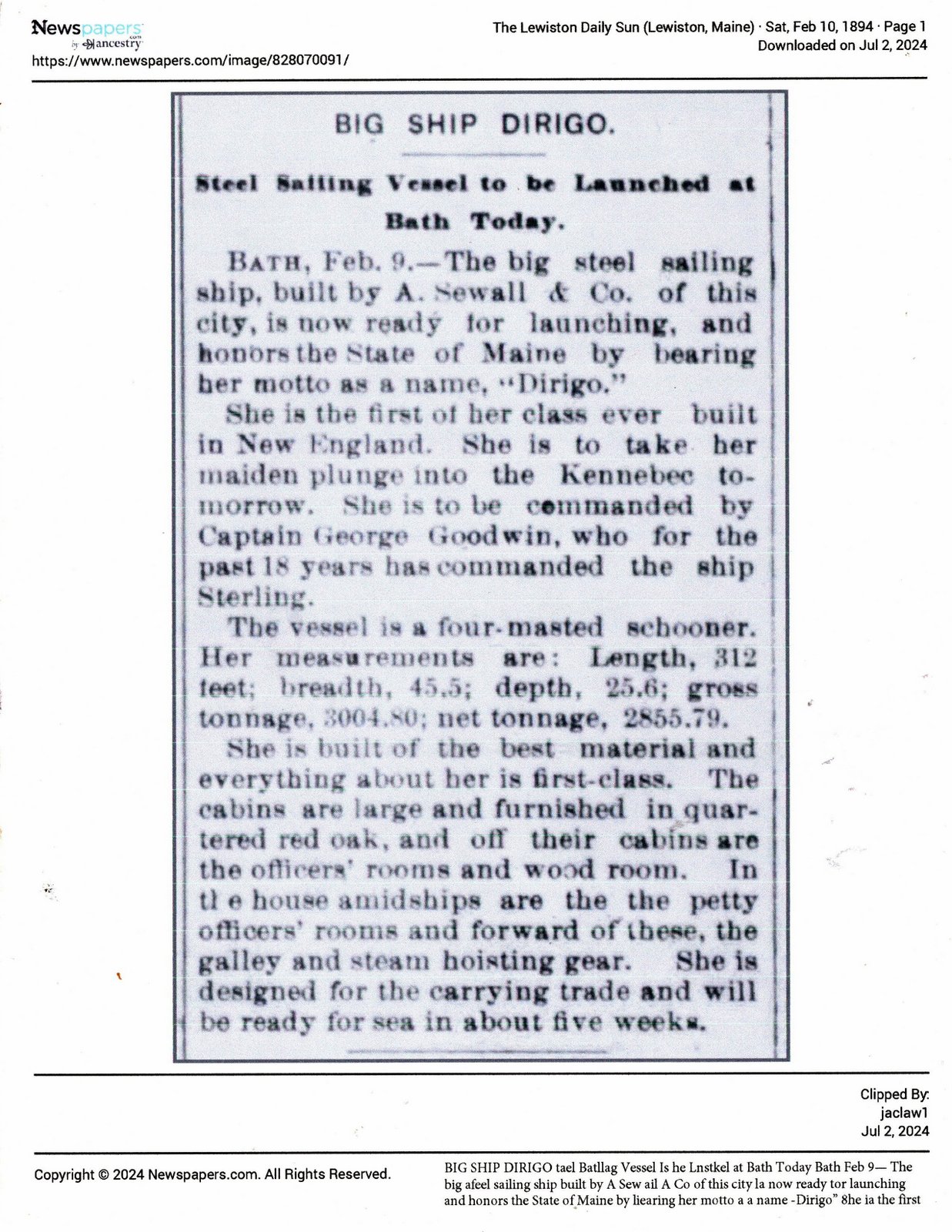
The first steel hulled ship built in the United States
It was not, however, on the Sterling that Captain Goodwin became best known as a ship’s captain but on the Dirigo, the first steel ship built in the United States. The Dirigo was launched at Bath, Maine on February 9, 1894. The steel plates for the hull were manufactured in Scotland and shipped to Arthur Sewall’s shipyard in Bath, Maine. Sewall saw the steel hulled schooner as the ship of the future, but his shipyard was the only yard in the country to build such ships and in the end only a few were built. The fact he entrusted his first to George Goodwin shows the level of confidence Sewall had in Goodwin’s abilities. Goodwin remained captain of the Dirigo for 15 years. The Dirigo’s maiden voyage was easterly from Philadelphia to Kobe Japan with a return to New York around Cape Horn- April 26, 1894, to July 23, 1895, nearly a year and three months. The second trip was from New York to San Francisco October 3,1895 to March 4, 1896, and as to this journey we know a good deal. Charles F. Murchie, a Calais man and one of the local lumber baron Murchies, was a passenger on the trip and kept a detailed log. On board according to his journal were 30 men and the captain’s wife Ada.
For those who have never read the log of a passenger on a long sea voyage it is fair to describe such accounts as generally deadly boring with a slight bit of excitement on rare occasions at the sighting of a strange sea creature or bird. Otherwise, the log is basically a weather report. However, when the weather is bad, the winds fierce and the seas high, life on board a sailing vessel could be terrifying for landsmen and seamen alike. Even the most accomplished sailor dreaded rounding Cape Horn at the tip of South America.
Charles Murchie left his home in Calais in September 1895 to meet the Dirigo in New York:
Monday, September 23, 1895- left home at 8 PM bound to New York. Father with me. Took a sleeper at McAdam Junction. Arrived in Boston next day at 9 AM. Went to the Quincy house and stayed all day. Tom Murchie with me. Bade him goodbye at 2 PM. At five we went to Fall River and took the steamship Puritan for New York. Arrived in New York at 7 AM Wednesday. Went to H. B. Murchie and company, office at 82 Wall Street. No one was there, so went down to the ship Dirigo, and had breakfast. On Thursday father left for home. I stayed in New York until Tuesday, October 2. At 8 AM on board ship Dirigo bound for San Francisco. 19, East River taken to Sandy Hook lightship by three tugboats. They left us at 1 PM and went back. At 3 PM under full sail with a light breeze from Southwest. At 8 PM almost a full moon and beautiful. She had as a passenger Dr. Addison of Washington.
A typical journal entry:
October 7 – Monday at 7 PM a nice breeze, quite a sea on. At 12 o’clock wind light and sea going down. Same weather p.m.
Occasionally the First Mate has to establish who was in charge:
October 8 – Tuesday: at 7 AM nice breeze from Southeast. Everything set but skysails. At 11 AM took in light sails. Wind is East Southeast, good breeze. Mate has a fight with a sailor and gave him two black eyes. Good breeze all p.m. made 192 miles today.
The ship spent many days in the doldrums:
October 31 – Thursday: at 4 AM on the deck and had a salt bath. Ship in doldrums. At 12 clear and fine, latitude 6° 22 longitude 27° for. At 230 spoke to a German Man of War and asked her to report us. Had a good many rain squalls. Latitude 5° 55 – longitude 27°
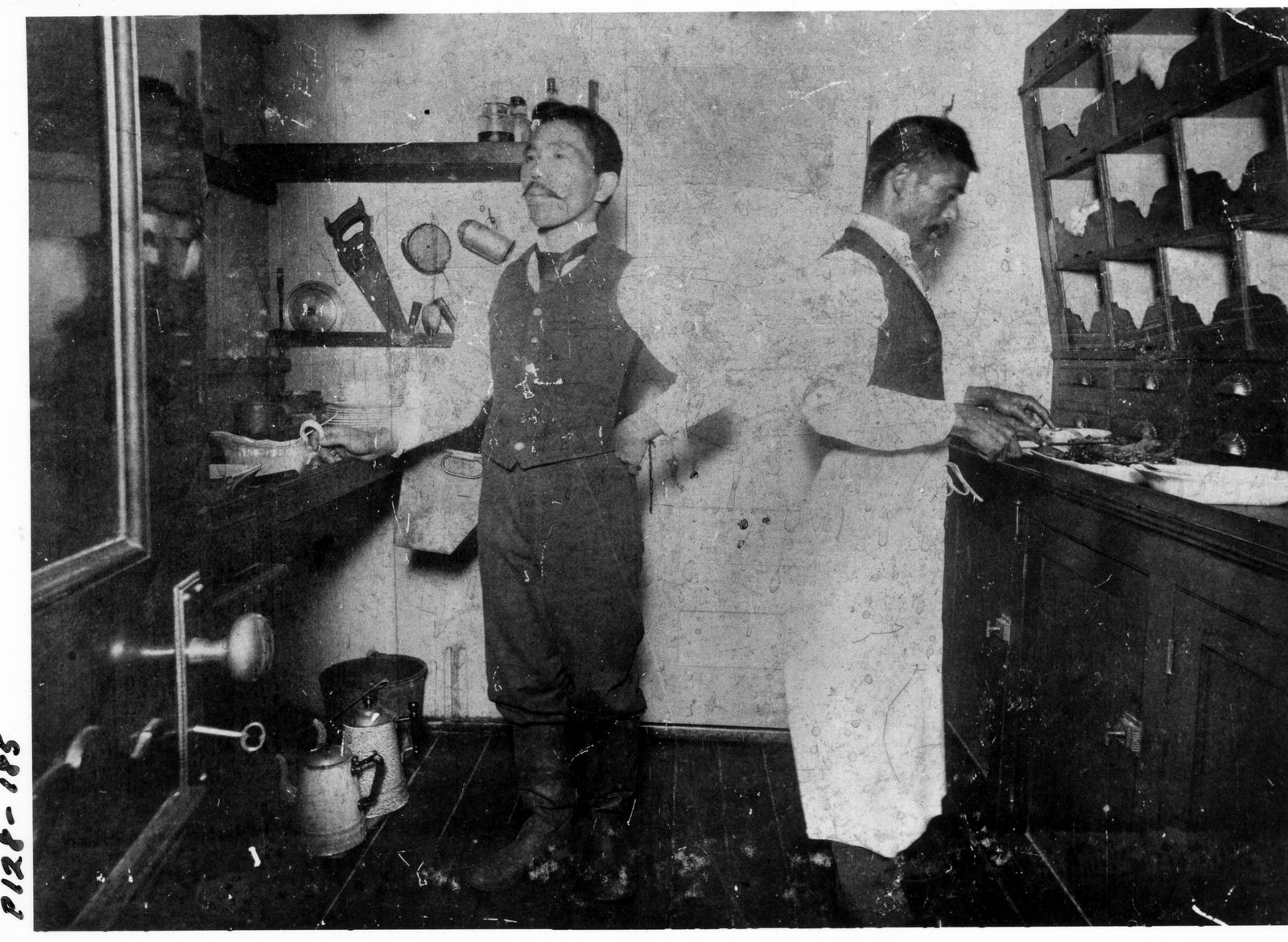
The Japanese cabin boy and cook on the Dirigo
Accidents on the rolling sea such as this one in the ship’s galley were common:
November 14 – Thursday: at 7 AM cloudy and misty with no wind. By 8 AM raining hard, continue so all day. No site today to get the latitude. Dr. Addison sick today. At 9 PM very dark. The second mate went into the pantry to get a drink and the steward had a lot of pies and cookies on the shelf cooling. The first thing the mate stepped into a pie, and before he got out he had stepped into all of them and broke the dishes all to pieces.
Approaching Cape Horn everyone was excited and anxious. The clearing of the Cape was to take weeks.
December 11 – Wednesday: 70 days out. At 7 AM fine and clear, wind hauling and freshening. At 12 o’clock wind Southwest and blowing hard. Under three lower top sails. At 3 PM raining hard. At 8 PM moderating. Latitude 50° 34 min. longitude 64°. Beginning of Cape Horn. Days getting long.
December 12 – Thursday: at 7 AM blowing a Gale from the Southwest with heavy seas. Heading North West by West. Saw sea lions today. Last night first mate and sailor had a row, one had a revolver, the other a knife. No harm done. At 11 AM wore ship and stood Southeast. Latitude 50° 50 longitude 63° 47. In 1 PM moderating. At 9 PM wind fair North making 7 kn.
It took them until January 2nd to round the Cape. They spent Christmas in a life and death struggle with the sea.
December 23 – at 7 AM blowing a living Gale with a terrible big sea. Things are cracking and rolling around in good shape. Wind southwest – blowing hard. Ship rolling so she takes in water over both rails. When some of the waves hit her you would think it was an earthquake. Under three lower top sails. Barometer 28 – 50 decks full of water. Heading east by South – hope to, drifting to leeward about 3 miles an hour. At 10 AM water about 4 feet deep on deck. Seas 40 to 50 feet high. Blowing a hurricane. When she rolls the deck is on an angle of 30°. Just the same all p.m. Second mate blacks a sailor’s eye for leaving wheel. At 12 PM moderating after 40 hours of it. (In the margin of the diary is a note – this is a nice place to spend Christmas holidays – a hell of a place.)
December 24 – Tuesday: at 7 AM cold and cloudy – 6 inches of snow on deck. Hailstones like marbles. Wind light from Southwest. At 9 AM a boat and 10 or 12 water spouts around us. Took sail about all in, left to lower top sails. Sometimes they strike a ship and take masts and all and tear them up. They are wild looking things. The first one we seen we thought it was a ship on fire. Snowed a boat all a.m. At 12 o’clock quite clear, when Southwest we were blown back 60 miles in a gale. Latitude 56° 47 min. longitude same as Cape Horn. At 2 PM caught an albatross, saved his wings and bill, also feet. At 10 PM snowing, cold and dreary, wish I was home tonight for Christmas.
December 25 – Christmas Day 85 days out. At 7 AM fine and clear. Nice breeze from South. Heading West comparatively warm. Hope they are having a nice time home. Just off Cape Horn. Santa Claus came and left us each a present. Latitude 57° 4 min. longitude 67° 10 min. fixed the albatross wings, feet and bill this morning. Had a nice dinner. Menu – barley soup chicken salad cold ham potatoes peas cake jelly tarts salted almonds coffee tapioca pudding. Around 3 PM there was no wind. From 7:56 PM dogwatch, Dr. Addison and myself. Got the sailors together and had all kinds of games. 150 yard dash, sack race, potato race, three-legged race, grab race, ring toss and the bowling race. Made a donkey and had them pin the tail on. They enjoyed it very much. Then gave them some grog and tobacco. We bought the tobacco from the Capt. They were very much pleased. At 8 PM light breeze from Northwest. At 10 freshening fair wind.
A week later they had finally managed to round the Cape. It took nearly 30 days to traverse a distance of 150 miles.
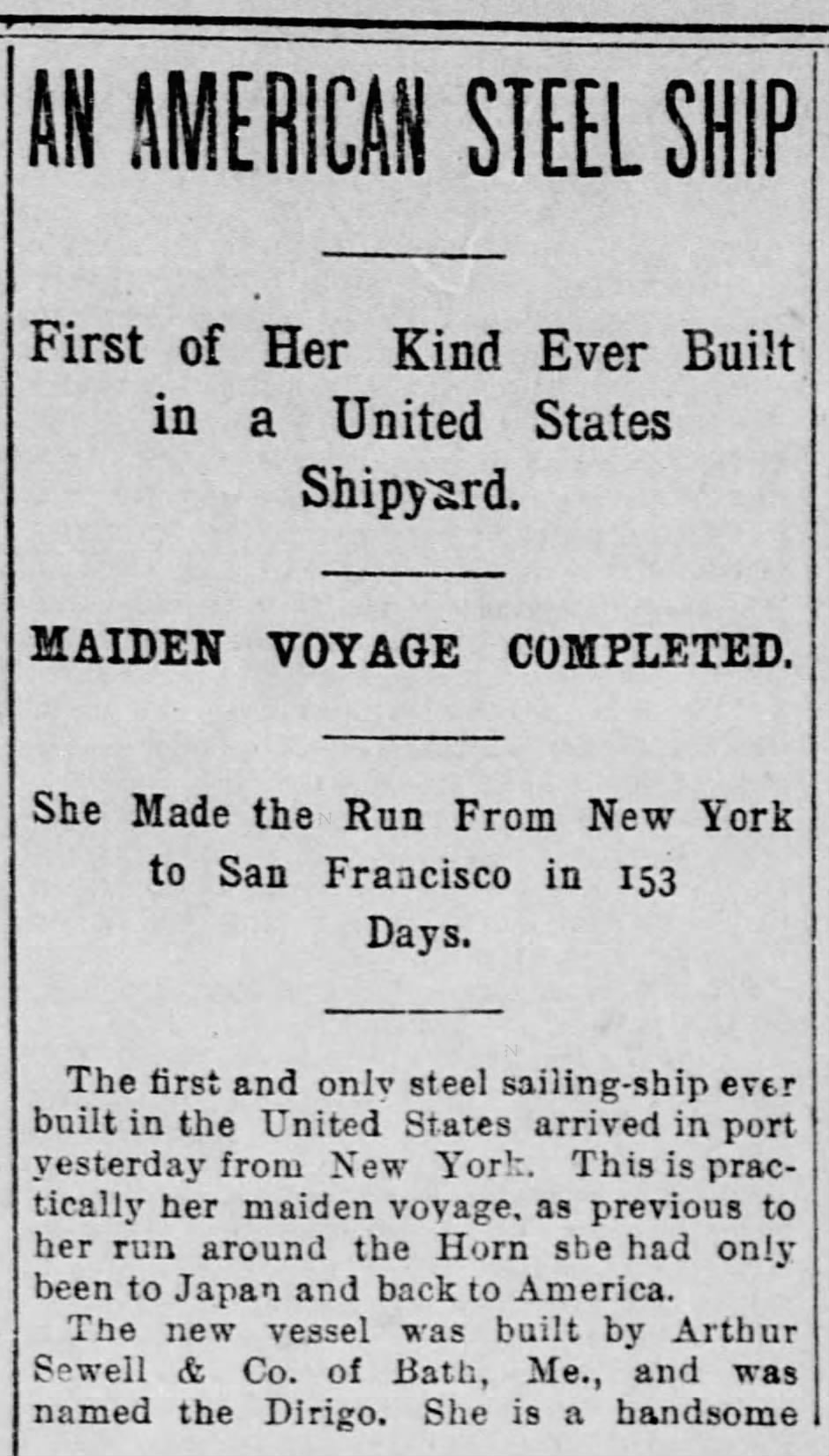
They docked in San Francisco on March 3rd, 1896.
Charles Murchie did not stay long out west. He returned to Calais and was for many years a foreman at the Murchie Mills and owned a lumber business in Calais during the First World War. He died in 1928 in Brooklyn where his family maintained wharves and a lumber business, but he is buried in the Calais cemetery.
There was a good deal of controversy regarding the ship and the voyage in the San Francisco newspapers. It was rumored the ship was leaking and sluggish although Goodwin denied this. He did admit in official reports that the ship was slow although subsequent adjustments corrected these deficiencies. The crew, however, was deeply disaffected.
The San Francisco Call reported on May 30, 1896, after the Dirigo had returned to San Francisco after a trip to Hawaii
The only American steel built ship in the world, the Dirigo, is getting into ill repute. She left here for Honolulu to load sugar and on arriving at that port the crew deserted. They say – those who have reached San Francisco- that they were not half fed and had to do double work. One of them got away on the British ship Hollingwood and two arrived yesterday on the bark Martha Davis. They made themselves a bed among the sugar in the hold of the bark, and although the captain of the Dirigo and the Honolulu chief of police searched for them- their hiding place could not be found. When the Martha Davis was outside the reef the men came on deck and sooner than put back to land them Captain Soule brought them to San Francisco. They say that all hands attempted to desert on account of ill treatment, but that all were arrested except for four. According to them the ship was a hell upon earth and the captain and officers fiends incarnate.
Before the trip from San Francisco to Honolulu the second mate of the Dirigo, Bartlett Taylor, had been discharged by the captain. He walked off the end of pier into the water and drowned. These incidents, the long voyage and conflicts on board certainly indicate all was not well on the voyage from New York.
For the next 15 years Captain George Goodwin sailed the Dirigo around the world, through the Cape of Good Hope at the tip of Africa and around the tip of South America at Cape Horn where the prevailing westerlies can reach speeds of over 60 miles per hour. It was the journey around Cape Horn which finally brought Goodwin to shore for good. Before his retirement he and his wife had spent most of their shore time in New York, Baltimore, Philadelphia, Honolulu Kobe, Liverpool, Queenstown, Shanghai, San Francisco, Sidney, Rio De Janeiro and dozens of ports in between.
In 1909 Captain George Goodwin gave up the sea and retired to Brighton Massachusetts. A number of articles were written about him and his adventures on the high seas. What it took to make a landlubber of the brave Captain is described below.
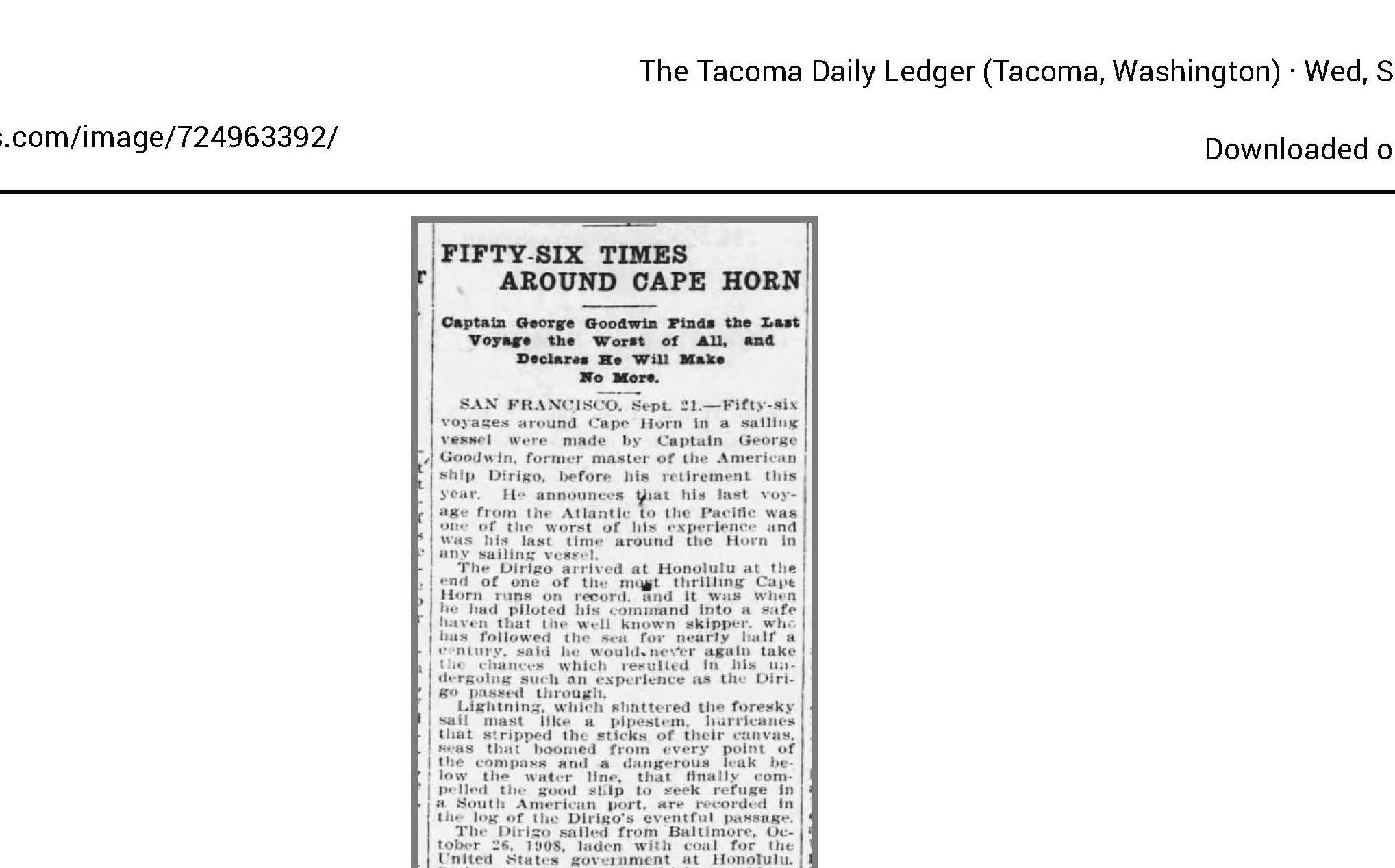
Tacoma Washington Daily Ledger 9/22/09
FIFTY-SIX TIMES ABOUND CAPE HORN
Captain George Goodwin Finds the Voyage the Worst of All, and Declares He Will Make No More
SAN FRANCI8CO Sept 21— Fifty-six voyages around Cape Horn in a sailing vessel were made by Captain George Goodwin former master of the American ship Dirlgo before his retirement this year. He announces that his last voyage from the Atlantic to the Pacific was one of the worst of his experiences and was his last time around the Horn in any sailing vessel. The Dirigo arrived at Honolulu at the end of one of the most thrilling Cape Horn runs on record and it was when he had piloted his command into a safe haven that the well-known skipper who has followed the sea for nearly half a century said he would never again take the chances which resulted in his undergoing such an experience as the Dlrlgo passed through. Lightning which shattered the foresky sail mast like a pipestem, a hurricane that stripped the sticks of their canvas, seas that boomed from every point of the compass and a dangerous leak below the water line that finally compelled the good ship to seek refuge In a South American port are recorded in the log of the Dlrigo’s eventful passage. The Dirigo sailed from Baltimore October 26, 1908, laden with coal for the United States government at Honolulu. Owing to a heavy gale which was blowing from the eastward the ship was compelled to anchor off Cape Henry and did not square away for sea until the following Friday. The Dirigo soon fell in with the ship Acme bound for this port and was in her company for some time, each vessel piling on canvas and trying to outsail the other. For several days the Dirigo and the Acme were together with strong west and northwest winds blowing at the time and in the bad weather the two vessels parted. And here Dlrigo’s trouble began with the loss of several sails. “After that” as Capt. Goodwin expressed it “things came in bundles”. “At the height of the terrific wind” said the skipper “the ship rolled from side-to-side groaning in every timber, shipping seas fore and aft as well as taking them from the northwest and the southwest over the beam.” On the afternoon of Nov 6, the carpenter staggering aft on the pitching ship reported to the master that the vessel was leaking. No more startling Information can come to a skipper’s ears on the high seas when the nearest port lies hundreds of miles away over the threatening waste of ocean. Capt. Goodwin acted quickly. The leak was discovered to be below the water line. The water rushed in through a crack in a plate 12 feet under the sea. To stop the flow of the water which was rapidly flooding the hold with a sickening gurgle, Capt. Goodwin made a pad out of cotton batting, soaked it in white lead and placed It over the crack. Then over this was fastened a plank. There was no water in the hold when the pumps were sounded at 8 o’clock that morning but when the lead had been stayed it was found that the hold contained two and one-half feet of brine. “We pumped out as much water as we could” continues Capt. Goodwin “and then I took up the floor and hoisted the rest up through the lazaret hatch using a big oil drum. We were two days getting all of that water out “As the leak was so far aft, I thought at first that I could build a bulkhead filled with cement to stop the leak and keep on my voyage. I worked on this scheme for several days but in spite of all that we could do the water continued to force its way In and wash the cement away. We had to hoist from 40 to 50 barrels of water out of the hold every day. So, it seemed that I could do nothing, and I decided to go into Rio for repairs. Two days after the gale we sighted the Acme with her top gallant mast gone. She too had had a taste of the medicine which the elements had been giving us.” The following Friday after the Dirigo sprang a leak she ran into another gale which was accompanied by thunder and lightning. One bolt descended on the foreskysail mast rending it to splinters on the heaving decks below, but the crew considered themselves lucky in not suffering any worse. “On the evening of Nov 24” Capt. Goodwin relates “we saw an unusually large comet which seemed to be standing on its head. It had the longest tail of any comet I ever saw and it was in sight for two evenings” The Dirigo finally lumbered Into the harbor of Rio Janeiro where she remained long enough to make repairs and collect a nice bunch of barnacles, the latter having the effect Capt. Goodwin dryly observes of making the old ship sail slower than a bale of hay with paddles. This eventful passage ends my 56th and last passage around Cape Horn concludes Capt. Goodwin “and I’ve had enough this time”.
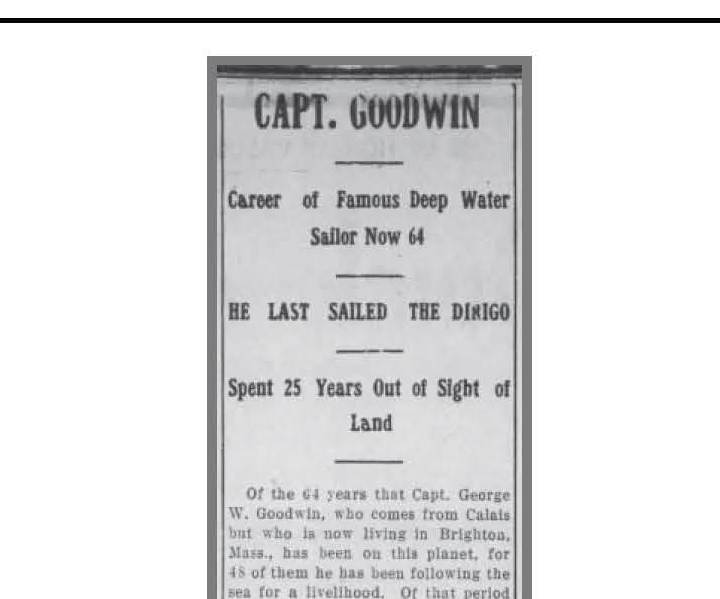
Brunswick Maine Record 1913
Interviewed at his Brighton home Goodwin describes his retirement:
CAPT GOODWIN
HE LAST SAILED THE DIRIGO
Spent 25 Years Out of Sight of Land
Of the 64 years that Capt. George W Goodwin, who comes from Calais but who is now living in Brighton, Mass has been on this planet for 48 of them he has been following the sea for a livelihood. Of that period 45 years have been passed as a genuine deepwater sailorman — a man whose voyages invariably were round either Cape Horn or the Cape of Good Hope.
In Capt. Goodwin’s life a full quarter of a century — if the days were placed end to end — has been lived out of sight of land. It has been lived in fact out of sight of everything except blue water unless you choose to count his ship — a thing apt to become pretty monotonous and tedious as one’s entire world after three or four months at a stretch — and an occasional sail or a patch of smoke on the horizon.
Such a record would lead you to expect to see the typical old shellback. On the contrary you’ll find a clean-shaven man looking to be scarce 50 with less grey hair on his head than the average man of middle age— and apparently not a particle of shortage in that hair.
Possibly Capt. Goodwin thought 56 slants around the Horn with 12 or 15 whirls round the Cape of Good Hope thrown in for good measure was enough. Be that as it may in Honolulu in 1909, he “said he wasn’t going round the Horn anymore and since that time he had been trying to get acquainted with the land.
Last autumn his dry land voyages fetched him up in Brighton and there he finds himself today contented with being on the retired list contented with lying up in drydock as it were. Frequent and regular visits to the marine room of the chamber of commerce, to the room of the pilot commissioners and to the headquarters of the Boston Marine Society prevent the time from hanging heavy on his hands.
A glance around the walls of the den at home and the sound of chart-room bells instead of the ordinary land-going hours from 1 to 12 carry him back to the sea again in imagination whenever he feels the need of it.
The old days are gone anyway. And gradually but surely under full sail— the poetry of the ocean — are being forced to drift aside for steam and oil but the memories remain. And Capt. Goodwin’s den in Brighton is a place where memories thrive well.
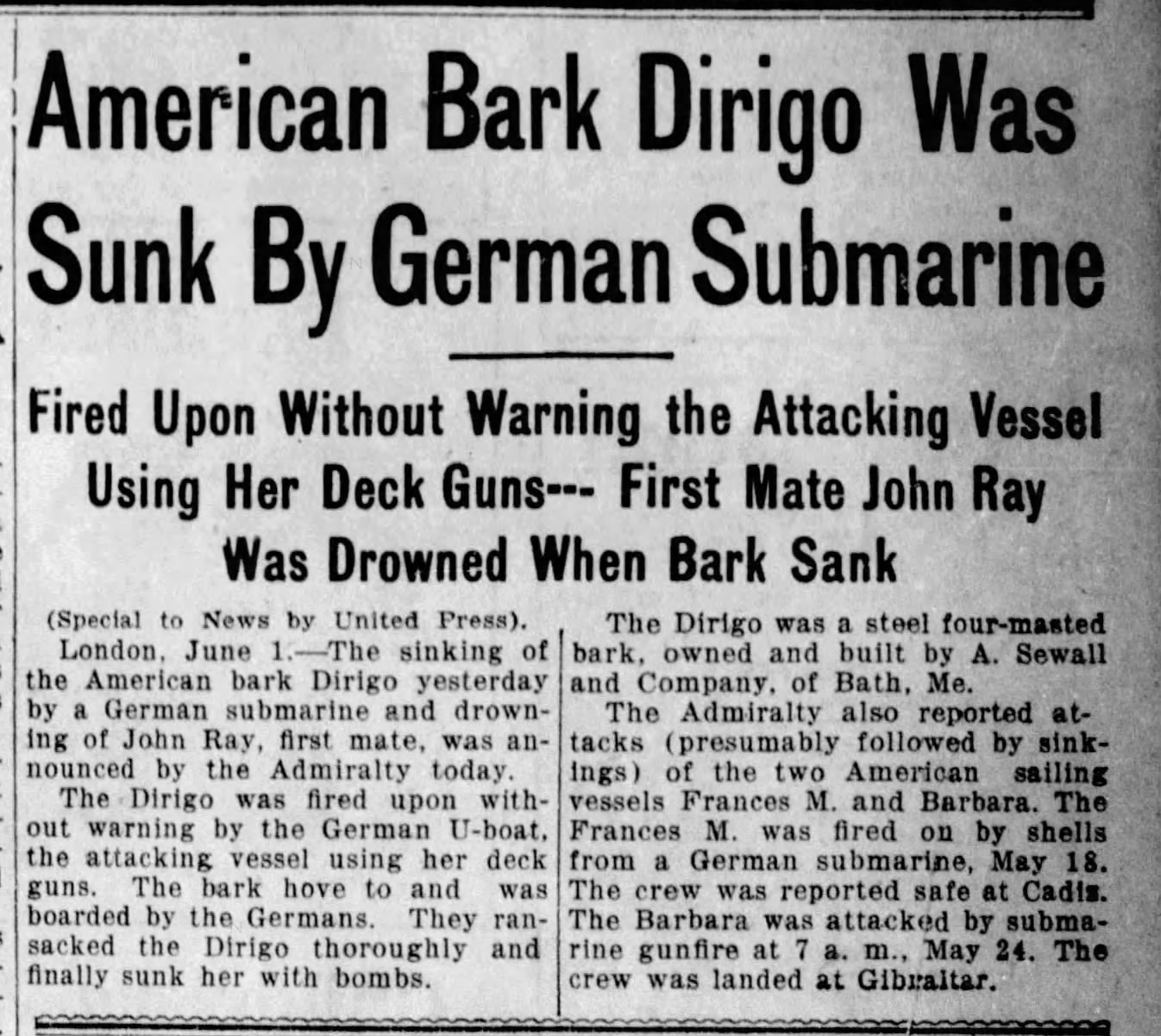
The Dirigo was one of the first ships to be sunk by a German submarine during WW1
The Dirigo was a sturdy ship and remained in service until sunk by a German submarine off England soon after the United States entered the war against Germany in 1917. The sinking so alarmed maritime authorities that ports on the East Coast of the United States were closed for some time after the sinking.

